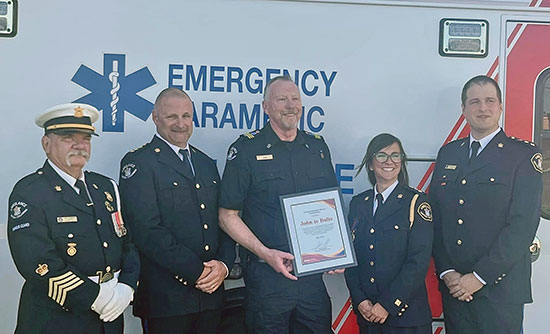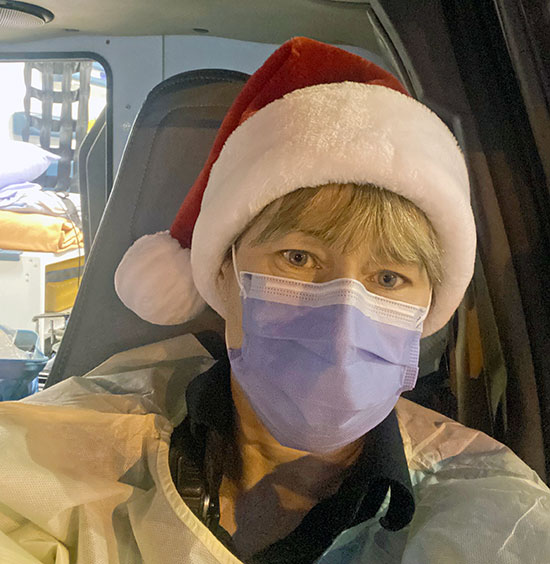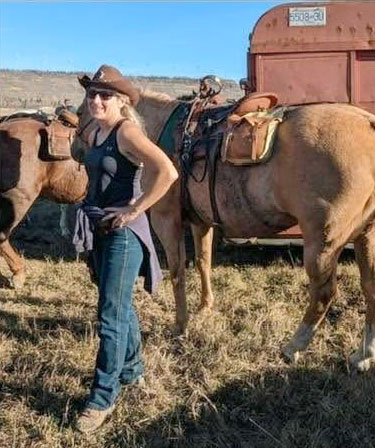by Jane Campbell
This fall, BCEHS staff from all over the province gathered in the Lower Mainland to celebrate 177 paramedics, emergency medical call takers, dispatchers, patient transfer team members, managers and other employees who reached long service milestones. Among them were John te Bulte and Dawn Reierson, two paramedics from the Peace Region in Northeast BC.
John, who is the unit chief of Fort St. John, received his 40-year long service award, and Dawn, a primary care paramedic in Dawson Creek, was recognized for 25 years of service. A third Peace region paramedic, Russell Kitchen of Dawson Creek, was recognized for 35 years of service but wasn’t able to attend the ceremony.
Located on the eastern side of the Rocky Mountains, the Peace region has rolling hills and more sunshine than the soggy coastal regions of the province – Fort St. John holds the BC record for most hours of sun in the months of March, May and November.
As is the case in many rural areas of the province, the long distances between communities and health-care facilities can make delivering emergency care more challenging. However, there’s also a special closeness and sense of community in the area.
“If something goes wrong, six different families show up,” says Dawn. “If you have a fundraiser in Dawson Creek, there’s not an empty chair. In this town, we’re really there for each other.”
With their decades of service, Dawn and John exemplify the commitment of BCEHS paramedics to being there for their communities when they’re needed most. Their career journeys also show how the ambulance service has evolved over the years, particularly in rural and remote parts of the province.
John started his career in the forestry industry, and when his supervisor asked for volunteers to take a First Aid course, he raised his hand, only belatedly realizing he’d be spending two nights a week and every Saturday in the class for five weeks.
Fortunately, John realized he enjoyed first aid work, and he soon became involved in First Aid competitions, where teams respond to different staged industrial accidents to test their skills and speed. The captain of his team worked in the ambulance service and suggested John apply. On June 18, 1984, John was first hired as a paramedic.
For years John worked on a casual basis for the ambulance service in the communities of Fruitvale and then Revelstoke, while continuing his full-time career in the forestry industry. His time in the ambulance helped him sharpen his medical skills, which he knew would come in handy if he needed to help respond to an emergency at his “day job.”
“I was always an advocate for anyone who had a First Aid certification to join the ambulance service so if something happened in industry, you’d be prepared,” he explained. “That’s kind of why I stuck with it, because it helped me with my work.”
In 2000, John upgraded to a primary care paramedic (PCP) license. He started working more regular hours for BCEHS and scaling back his work in logging. In 2003, he moved to the Peace region. After holding several acting unit chief roles over the years in both Dawson Creek and Fort St. John, he became the permanent unit chief of Fort St. John in 2022.
Over his years working in logging and building his career at BCEHS, John was also raising seven children and taking them out to enjoy the natural beauty of British Columbia through skiing, camping and other outdoor activities.
His long journey to a full-time, permanent position at BCEHS is a common one among paramedics of his generation. Until recently, paramedics often had to spend years working in casual or part-time roles and moving from community to community before landing a full-time position. You can read more about how the BCEHS hiring process has changed over the years in our 50th anniversary story “The Great Paramedic Migration.”
As unit chief, John now supervises thirty-two paramedics with full-time roles, including a number who are early in their careers.
“The opportunities that have become available for crew members over the last few years are phenomenal,” John says. “I’m looking back thinking I wish I was twenty again so I could get a full-time position like these guys, and I’m so happy for them. It’s just a great career.”
As unit chief, John helps ensure that the Fort St. John station is running smoothly and provides support and guidance to the paramedic he supervises.
“My favorite part is supporting the day-to-day stuff,” he says. “We have some people in this organization who are visionaries and looking at ten years down the road. I’m looking at today and tomorrow and the end of this week. That’s what I really like, is making sure we’re doing the day-to-day well.”
John’s talents for everyday problem solving were put to use in May 2024, when the entire community of Fort Nelson was evacuated due to a wildfire. This included evacuating the local hospital and ambulance station. John worked together with his fellow paramedics at the Fort St. John station to help support the fire evacuees, many of whom stayed in Fort St. John and Dawson Creek for several weeks until the danger passed. This included providing support to a number of paramedics from the Fort Nelson station who’d had to leave the community along with their families.
In recognition of his efforts, John received a BCEHS Chief Operations Officer’s Commendation, which Senior Provincial Executive Director Jenna Dietz surprised him by presenting at a station barbeque.

(Pictured from left to right: Mike Wright, Port Renfrew Unit Chief and BCEHS Honour Guard; Nathan Cook, Clinical Operations Manager; John te Bulte; Jenna Dietz; John Brnjas, Clinical Operations Director)
John and his colleagues at the Fort St. John station continued to step up over the summer, when paramedics and other health-care workers came into town to help out when the region was impacted by emergency department closures. Along with his fellow paramedics, John helped ensure that the visitors were welcomed into the community, had rides from the airport and knew where to get food and groceries during their stay.
“We made sure they knew that they were being picked up, that they had a hotel room, that they knew when their shifts were,” he says. “We’ve had many people come back because the experience has been pretty smooth.”
When thinking about his goal as a unit chief, John is reminded of a question posed at a talk he attended a few years ago. The speaker asked the audience to think of the two or three people who’d really made a difference in their lives, and then he asked them, “Who’s got you on their list?”
“That’s my goal,” John says, “to be that support person. As a unit chief, that’s my number one job is to support, to make sure my staff are being supported emotionally and physically, to make sure they’re taken care of and being paid on time. It’s not a punitive role, it’s a support role.”
Dawn Reierson’s career in health care began in much the same way as John’s did, with a First Aid course she took while working in industry. Her teacher in the course was a paramedic.
“She inspired in me a love of the human body that I didn’t really understand before,” Dawn says. “She dragged me down to the ambulance service and said ‘you have to do this. You have a gift.’”
Dawn was 19 at the time and she didn’t take her teacher’s advice right away, but eventually, five years later, she joined the ambulance service.
“When I walked through the door she was teasing me,” Dawn says of her former teacher. “She was a regional training coordinator for BC Ambulance Service as well and she actually went on to be the master of ceremonies at my wedding, so we’re still good friends to this day.”
When Dawn started to have children, she found it difficult to continue working as a paramedic. At the time, like many paramedics in rural and remote areas, she was working on-call and carrying a pager, only receiving her full wages when she was called out to an emergency. Arranging childcare to cover on-call hours simply wasn’t practical. As a result, Dawn started teaching First Aid and emergency medical responder courses while still doing occasional work as a paramedic.
As a teacher, Dawn is now the one in a position to recognize young people with a natural talent for paramedicine.
“I get them in class and I’m like ‘oh you’re one of us,’” she says. “You have to have a certain combination to be really good at this and every once in a while, you just see someone who has the gift. I’ve had the pleasure of watching a couple students make it all the way up the ranks and sit in the chair beside me.”
When her children were older, Dawn was finally able to secure a full-time role, 19 years after she started at BCEHS.

After having to put her paramedic career on hold for so many years, Dawn is greatly appreciative of what recent changes in paramedic hiring practices mean for other women in the service.
“Women with kids can actually do this for a living now,” she says. “It used to be once you had kids, you never came back, so it’s nice to see that we can have these opportunities now.”
Somewhat unusually for a paramedic, Dawn has worked most of her career in the community where she grew up.
Being able to serve the community where she’s lived almost her entire life is particularly meaningful for Dawn.
“I never forget that it’s a privilege to be invited into people’s homes,” she says. “We show up to the worst moments of their lives, and we can’t always fix them, but we get an opportunity to make it a better day than it was before we showed up.”
Dawn has seen how recent challenges in the health-care system, including emergency department closures, have caused stress and frustration for the people in her area. She has also seen how committed her fellow paramedics are to stepping up and doing everything they can to ensure people in the community get help when they need it.
“I want everyone to know they’ve got some good people in their corner, and we’ve got their backs. We’ll do what we can,” she says.
Although Dawson Creek and Fort St. John are about an hour apart, and John te Bulte doesn’t usually work with Dawn directly, he’s well aware of her commitment to her community and the other paramedics she serves with.
“Dawn’s a real advocate for the North,” he says. “She’s always doing things for the station like organizing the annual barbeque. She makes sure BCEHS is represented at community events and teaches a medic program at the local high school. She’s just a real ball of fire for community engagement.”

Like most paramedics though, Dawn is incredibly humble about her work and the sacrifices she’s made to be there for people in their time of greatest need.
“People are so wonderful and generous, and they thank us and call us heroes,” she says. “I see it slightly differently. We’re not heroes. We are servants. We’re there to be there for the public. We’re there to help. We’re there to serve. The heroes in my life are the ones who picked up my kid from volleyball practice because I was on a critical call or made me a lasagna because I’d just worked three night shifts. We can’t do it without the support of the community and our family and friends.”

